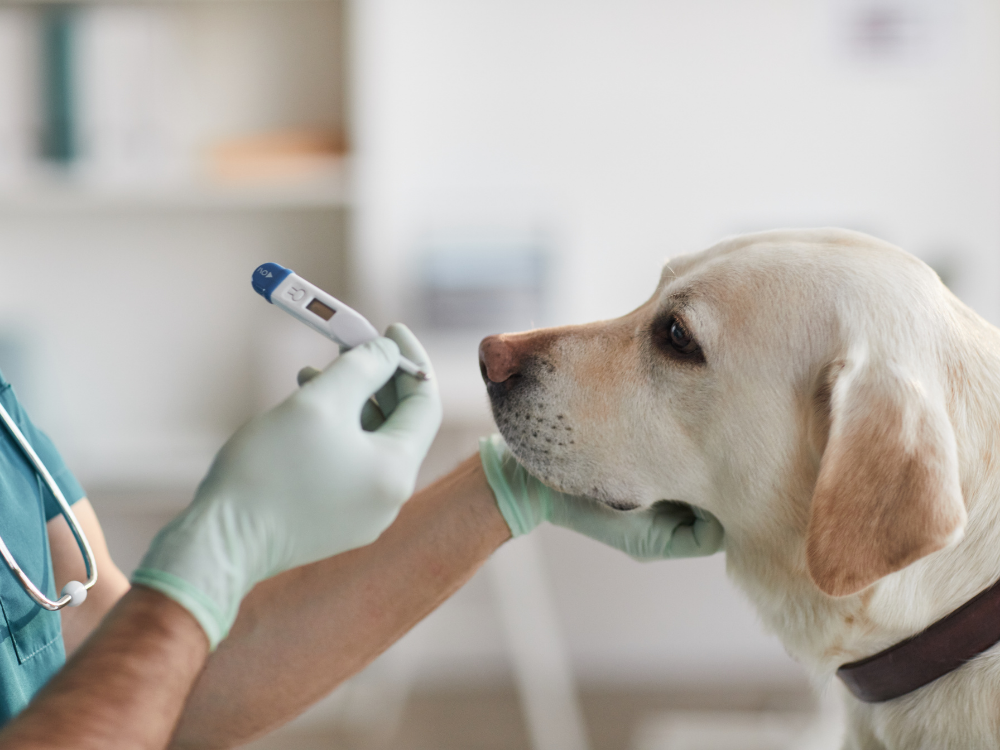Finding the Best Thermometer for Dogs
One tool for monitoring our beloved dogs’ health at home is a thermometer for dogs. By taking their temperature if they seem under the weather and by establishing a baseline through monitoring, we can know when it’s time to call a trusted veterinarian.There are a lot of choices and considerations, though. Thanks to technological advances, old-school mercury thermometers are out – it’s the era of the digital thermometer for dogs. So should you use a dog ear thermometer or a rectal thermometer for dogs? Can you check a dog’s temperature with a human thermometer? Read on to find out. All Pet Voices may receive commissions from affiliate links included in this article.
All Pet Voices may receive commissions from affiliate links included in this article.
Monitoring Temperature of Dogs
The average temperature of a healthy dog is higher than that of humans: around 101.5 degrees Fahrenheit. But a normal dog’s temperature range can vary depending on factors like the size, breed, age, and activity level of your pet.It’s important to get a baseline temperature for your dog, according to Page Mader, DVM, and co-owner of AAHA-accredited Five Parks Animal Hospital in Arvada, Colorado.“Some might run a little hot, some might run a bit cooler and that’s normal for them, just like people,” she told All Pet Voices. “That would give you a good baseline so in case they ever do get sick, you have something to compare it to.”It’s always helpful to identify and address health concerns early, which is why a temperature check is one of 5 health signs we help pet lovers monitor when you sign up for Pet Health 5. We’ll send you a checklist to monitor 5 health signs for your dog and easily log the results. It only takes 5 minutes and will help you stay on top of any changes to your pet’s overall health that might require veterinary care. Plus, with regular monitoring each month, you’ll learn how to check a dog’s temperature with ease.A fever can indicate cancer in some instances, but the most common causes are infectious diseases or immune-mediated diseases like immune-mediated polyarthritis (IMPA), immune-mediated thrombocytopenia (IMTP), and immune-mediated hemolytic anemia (IMHA), according to Dr. Mader.“Usually it means the body is attacking itself,” she explained. “It just depends on what the target is, like joints, platelets, or red blood cells. There are also multiple forms of immune-mediated skin disease.”A low temperature isn’t nearly as common as a high one, but dogs can cause concerns for general organ function or hypothermia, which is caused by low external temperatures.“When people don’t provide adequate housing for their pets during the winter, they’re going to become hypothermic,” Dr. Mader noted.Other causes of low temps include shock, endocrine disorders (hormonal imbalances), or major trauma to the body.
3 Thermometers for Dogs
There are three main types of thermometers for dogs. Your choice will depend on your individual dog.
Rectal Thermometers
Since it’s not feasible to ask a dog to lift his tongue so you can take his temperature orally – those teeth! – the traditional option is a rectal thermometer to check a dog’s internal temperature.The iProven Pet Thermometer for dogs (and cats) gets good reviews for having a soft, flexible, waterproof tip. That last attribute seems handy for cleaning the thermometer afterward, right?
Auxillary (aka Armpit) Thermometers
Sometimes rectal thermometers aren’t a good fit, however – such as when dogs bite or otherwise lash out when something is inserted, ahem, back there. A rectal thermometer for dogs is also problematic for dogs with diarrhea or a rectal mass.This is when an “auxillary” thermometer, which takes a temperature reading from the armpit, can be a huge help. For instance, Mella Pet Care recently launched the Mella Home Pet Thermometer. This digital thermometer for dogs gives a reading from inside a foreleg or hind leg within 10-15 seconds. You can use an app to record the data to your smartphone and easily send it to your veterinarian. (Pssst: use code APV10 for 10% off.)
Ear Thermometers
Some veterinary practices don’t even keep ear thermometers since a dog’s inner ear can be sensitive – plus, they’re not an option for dogs with ear infections. Still, they can be a viable option depending on your pet’s needs – and now there are many “no contact” ear thermometers.For instance, PetMedics offers an ear thermometer for dogs that gives results in one second and has a silent mode – which is a thoughtful touch since dogs have such strong senses of hearing.The most oft-cited advantage of an ear thermometer is having an alternative to rectal thermometers. But the con is a big one: they often aren’t reliably accurate, as noted by many reviewers. Proceed with caution (and check if there’s a warranty).
Can You Check a Dog’s Temperature With a Human Thermometer?
The answer to this question is a resounding, “Yes!” In fact, Dr. Mader normally uses an oral human thermometer with her canine patients – though she uses it like a rectal thermometer.Some human thermometers are designed to be used orally, rectally or under the armpit, like the Greater Goods Digital Oral Thermometer. The flexible (and water-resistant) tip is the key. Plus, the company prides itself on partnering with ethical factories and donating a portion of the proceeds to charity.You might see ear and forehead thermometers for humans and wonder about using them for dogs, but the most accurate readings will likely come from digital thermometers designed to take an internal temperature. (Not to mention, rectal and oral thermometers typically have longer tips than ear thermometers, and dogs have furry foreheads.) There’s even an old rule of thumb to add an extra degree to armpit readings since they aren’t for internal use.Whichever type of digital thermometer for dogs you choose, be sure to use caution if your dog is particularly sensitive or reactive to having her temperature taken. When in doubt, don’t hesitate to call your veterinarian!Because our dogs trust us, they are often amenable to having us monitor their temperature at home. Most readings come in 20 seconds or less, so it’s a quick way to make sure our dogs don’t have an underlying health issue. You can even make it a game by rewarding your dog with praise and then play or a treat – after washing both the thermometer and your hands, of course.Do you regularly monitor your pet’s temperature at home? If so, what is their baseline temperature? Performing a temperature check is one of the five vital steps to take each month to keep track of your pet’s health. We make it easy to remember to do when you join us in our Pet Health 5 movement. Just sign up and we’ll send you a reminder on the 5th of every month with a checklist of what to do and how to do it. Then you just take a few minutes to check your dog’s health stats and log them.Knowing your dog’s baseline temperature and monitoring for any changes can help detect potential issues early. You can be proactive about your beloved dog’s health by signing up for Pet Health 5.
About the Author: Award-winning journalist Jen Reeder is a self-proclaimed dog nut and former president of the Dog Writers Association of America. She writes bios of adoptable dogs and cats as a volunteer for the nonprofit PawsCo. Jen works from her home office in Colorado, which she shares with her husband and their beloved rescue dogs, Rio and Peach.